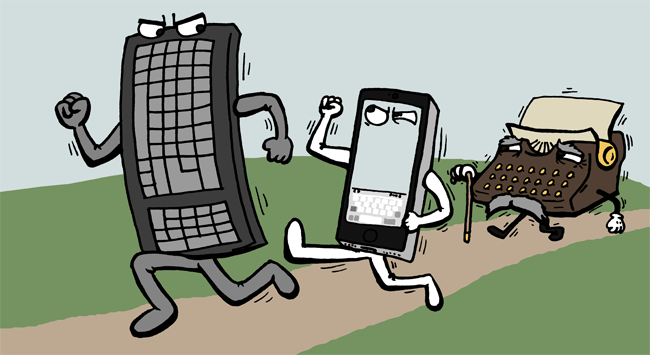Back in 2010, Austin was home to the Ultimate Typing Championship, where the winner, Sean Wrona, typed an extremely difficult passage full of unusual symbols and punctuation with an average speed of 124 words per minute. It is even more impressive when one considers that the keyboard he used, the standard QWERTY that we all grew up with, was not designed for nearly that kind of speed. In fact, the only reason we still use the QWERTY keyboard layout is for historical reasons, rather than practical ones. That is not to say that QWERTY is the only keyboard ever developed.
The very first typewriter, the Hansen Writing Ball, was drastically different. This device, which looks like a kind of steampunk pincushion, with many keys coming out of its semi-spherical body, was manufactured in 1870. It sat above a rolled sheet of paper and typed sideways with letters printed from top to bottom rather than left to right. Additionally, the machine completely covered the paper it wrote on, so users could not check for mistakes until after they had finished a page.
Thankfully, a few years later, E. Remington and Sons, produced a more sensible typewriter, with a flatter design that makes more sense to modern aesthetics. It also had the letters arranged in our current QWERTY order, but there are no known records that suggest how this order came about. Some suggest that the designers intended to slow down the typist and prevent typebars from getting stuck, but a closer look shows that this is not the case. For the English language, the QWERTY configuration is actually more likely to have colliding typebars than a randomly designed keyboard.
One thing is more or less agreed upon: QWERTY is not the optimal layout for somebody typing in English. The design overworks the pinky fingers. Each pinky finger is responsible for letters as well as “shift” keys. The left hand, non-dominant for the majority of the population, is used 57 percent of the time. In fact, the left hand can type many common words by itself.
Part of the reason for these problems is that the original typewriter was meant for “hunt and peck” typing, not touch typing. But that makes the design even more baffling, as studies have confirmed that it is much easier to hunt for letters if they are arranged in an order that makes sense, such as alphabetical.
With the exception of certain places in Europe where a few keys are switched, the design is used in a majority of countries across the world. People have proposed better designs, but, despite its flaws, QWERTY still works pretty well. Average typists easily achieve speeds of above 50 words per minute, and those with particularly speedy fingers can double or even triple that.
Those critical of QWERTY often choose Dvorak, a configuration designed to solve many of the problems inherent in QWERTY. When using Dvorak, the right hand does more work than the left and the most commonly used letters are on the home row. It also takes comparative finger strength into account. The index and middle fingers do more work than ring fingers and pinkies. There is also an emphasis on alternating hands, which results in faster typing with less exhaustion.
Unfortunately, these changes have not added up to any practical benefits. Despite several studies that have looked into it, there is no strong experimental evidence to suggest that the Dvorak keyboard provides a real improvement for most users.
It is unlikely we would arrive back at anything like QWERTY if we started from scratch, but at least we’re not stuck lugging around laptops that look like a Hansen Writing Ball.















